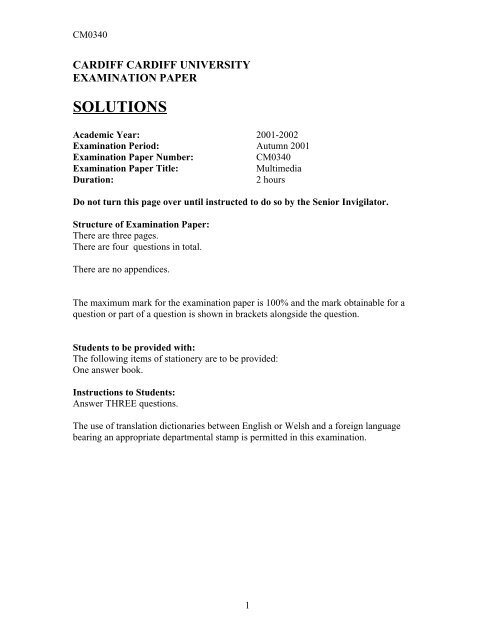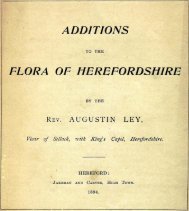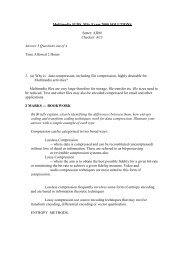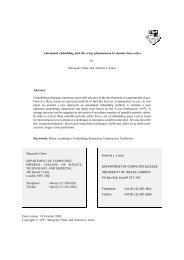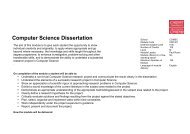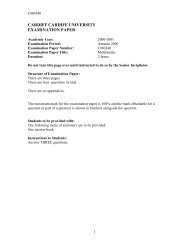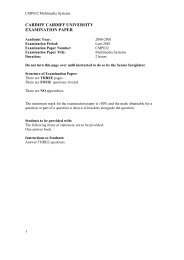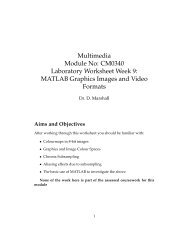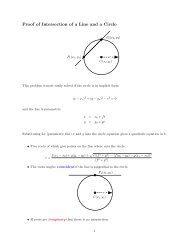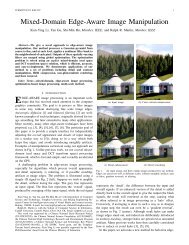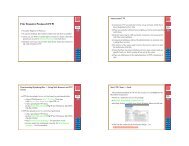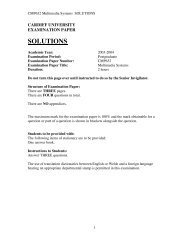Multimedia BSC Solutions 2002 - Cardiff University
Multimedia BSC Solutions 2002 - Cardiff University
Multimedia BSC Solutions 2002 - Cardiff University
- No tags were found...
Create successful ePaper yourself
Turn your PDF publications into a flip-book with our unique Google optimized e-Paper software.
CM0340CARDIFF CARDIFF UNIVERSITYEXAMINATION PAPERSOLUTIONSAcademic Year: 2001-<strong>2002</strong>Examination Period: Autumn 2001Examination Paper Number:CM0340Examination Paper Title:<strong>Multimedia</strong>Duration:2 hoursDo not turn this page over until instructed to do so by the Senior Invigilator.Structure of Examination Paper:There are three pages.There are four questions in total.There are no appendices.The maximum mark for the examination paper is 100% and the mark obtainable for aquestion or part of a question is shown in brackets alongside the question.Students to be provided with:The following items of stationery are to be provided:One answer book.Instructions to Students:Answer THREE questions.The use of translation dictionaries between English or Welsh and a foreign languagebearing an appropriate departmental stamp is permitted in this examination.1
CM03401. (a) Give a definition of multimedia and a multimedia system.<strong>Multimedia</strong> is the field concerned with the computer-controlled integration oftext, graphics, drawings, still and moving images (Video), animation, audio, andany other media where every type of information can be represented, stored,transmitted and processed digitally.A <strong>Multimedia</strong> System is a system capable of processing multimedia data andapplications.2 Marks - BOOKWORK(b) What are the key distinctions between multimedia data and more conventionaltypes of media?<strong>Multimedia</strong> systems deal with the generation, manipulation, storage, presentation,and communication of information in digital form.The data may be in a variety of formats: text, graphics, images, audio, video.A majority of this data is large and the different media may need synchronisation -- the data may have temporal relationships as an integral property.Some media is time independent or static or discrete media: normal data, text,single images, graphics are examples.Video, animation and audio are examples of continuous media4 Marks Bookwork(c) What key issues or problems does a multimedia system have to deal with whenhandling multimedia data?A <strong>Multimedia</strong> system has four basic characteristics:• <strong>Multimedia</strong> systems must be computer controlled.• <strong>Multimedia</strong> systems are integrated.• The information they handle must be represented digitally.• The interface to the final presentation of media is usually interactive.2
CM0340<strong>Multimedia</strong> systems may have to render a variety of media at the same instant -- adistinction from normal applications. There is a temporal relationship between manyforms of media (e.g. Video and Audio. There 2 are forms of problems here• Sequencing within the media -- playing frames in correct order/time frame invideo• Synchronisation -- inter-media scheduling (e.g. Video and Audio). Lipsynchronisation is clearly important for humans to watch playback of videoand audio and even animation and audio. Ever tried watching an out of (lip)sync film for a long time?The key issues multimedia systems need to deal with here are:• How to represent and store temporal information.• How to strictly maintain the temporal relationships on play back/retrieval• What process are involved in the above.Data has to represented digitally so many initial source of data needs to be digitise --translated from analog source to digital representation. The will involve scanning(graphics, still images), sampling (audio/video) although digital cameras now exist fordirect scene to digital capture of images and video.The data is large several Mb easily for audio and video -- therefore storage, transfer(bandwidth) and processing overheads are high. Data compression techniques verycommon.7 Marks BOOK WORK(d) An analog signal has bandwidth that ranges from 15Hz to 10 KHz. What is therate of sampler and the bandwidth of bandlimiting filter required if:(i) the signal is to be stored within computer memory.Nyquist Sample Theorem rate says that sampling must be at least twice the highestfrequency component of signal or transmission channelHighest frequency is 10 KHz soSampling rate = 20 KHz or 20,000 sample per second.Bandwidth of bandlimiting filter = 0 – 10 KHZ1 Mark2 Marks3
CM0340(ii) the signal is to be transmitted over a network which has a bandwidthfrom 200Hz to 3.4 KHz.Channel has lower rate than max in signal so must choose this a limiting highfrequency soSampling rate = 6.8 KHz or 6,800 sample per second.Bandwidth of bandlimiting filter = 0 – 3.4 KHZ2 Marks2 Marks7 Marks TOTAL: ALL UNSEEN(e) Assuming that each signal is sampled at 8bits per sample what is thedifference in the quantisation noise and signal to noise ratio expected forthe transmission of thesignals in (i) and (ii).Quantisation noise = V max /2 n-1SNR = 20 log (V maxa l/V min )So for (i) Quantisation noise = 78.125SNR = 20 log (10,000/15) = 56.48 DbAnd (ii) Quantisation noise = 26.56SNR = 20 log (3,400/15) = 47.11 Db7 Marks TOTAL: ALL UNSEEN3 Marks4 Marks2. (a) Why is data compression necessary for <strong>Multimedia</strong> activities?Audio and Video and Images take up too large memory,disk space or bandwidthuncompressed.3 Marks BookWork(b) What is the distinction between lossless and lossy compression?What broad types of multimedia data are each most suited to?4
CM0340Lossless Compression-- where data is compressed and can be reconstituted (uncompressed) without loss ofdetail or information. These are referred to as bit-preserving or reversible compressionsystems also.Lossy Compression-- where the aim is to obtain the best possible fidelity for a given bit-rate or minimizingthe bit-rate to achieve a given fidelity measure. Video and audio compression techniquesare most suited to this form of compression.Types sutabilityLosslessComputer data fles (compression)Graphcs and graphical images lossless (GIF/LZW)LossyAudio MP3Photographic images (JPEG)Video (Mpeg)5 Marks Bookwork(c) Briefly explain the compression techniques of zero length suppression and runlength encoding. Give one example of a real world application of eachcompression technique.Simple Repetition SuppresionSimplest Suppression of zero's in a --- Zero Length SupressionIf in a sequence a series on n successive tokens appears we can replace these with atoken and a count number of occurences. We usually need to have a special code todenote when the repated token appearsFor Example89400000000000000000000000000000000we can replace with894f32where f is the code for zero.5
CM0340Example:• Silence in audio data, Pauses in conversation• Bitmaps• Blanks in text or program source files• Backgrounds in imagesRun-length EncodingThis encoding method is frequently applied to images (or pixels in a scan line). It is asmall compression component used in JPEG compression.In this instance, sequences of image elements (X 1 ,X 2 , …X n )are mapped topairs (c 1 ,l 1 , c 2 ,l 2 …,(c n ,l n ) where c i represent imageintensity or colour and l i the length of the ith run of pixels (Not dissimilar tozero length supression above).For example:Original Sequence:111122233333311112222can be encoded as:(1,4),(2,3),(3,6),(1,4),(2,4)The savings are dependent on the data. In the worst case (Random Noise) encoding ismore heavy than original file: 2*integer rather 1* integer if data is representedasintegers.Examples• Simple audo• graphics• Images7 Marks Bookwork6
CM0340(d) Show how you would encode the following token stream using zero lengthsuppression and run length encoding:ABC000AAB00000000DEFAB00000Total length of token stream = 27Zero Length Suppresson CodeABCf3AABf8DEFABf5Number of tokens 17 where f is code for 0Run Length EncodingA1B1C103A2B108D1E1F1A1B105Number of tokens 26(i) What is the compression ratio for each method when applied to the abovetoken stream?Total length of token stream = 27Zero Length Suppresson CodeABCf3AABf7DEFABf5Number of tokens 17 where f is code for 0Run Length EncodingA1B1C103A2B107D1E1F1A1B105Number of tokens 26Compresson ratios:Zero length Supresson = 17/27Run Length Encoding = 26/273 Marks each for correct encoding2 Mark for each ratio10 Marks Total7
CM0340(ii) Explain why one has a better compression ratio than the other. Whatproperties of the data lead to this result?Data has only one repeated token the 0. So coding is wasted on rapidly changingremainder of data in run length encoding where every token frequency countneeds recording. 2 Marks12 Marks for all of PART (d) ALL WORK UNSEEN8
CM03403. (a) Briefly outline the basic principles of Inter-Frame Coding in Video Compression.Essentially Each Frame is JPEG encoded• Macroblocks are 16x16 pixel areas on Y plane of original image.A macroblock usually consists of 4 Y blocks, 1 Cr block, and 1 Cb block.• Quantization is by constant value for all DCT coefficients (i.e., no quantizationtable as in JPEG).The Macroblock is coded as follows:• Many macroblocks will be exact matches (or close enough). So send address ofeach block in image -> Addr9
CM0340• Sometimes no good match can be found, so send INTRA block -> Type• Will want to vary the quantization to fine tune compression, so send quantizationvalue -> Quant• Motion vector -> vector• Some blocks in macroblock will match well, others match poorly. So sendbitmask indicating which blocks are present (Coded Block Pattern, or CBP).• Send the blocks (4 Y, 1 Cr, 1 Cb) as in JPEG.8 Marks BOOKWORK(b) What is the key difference between I-Frames, P-Frames and B-Frames?Why are I-frames inserted into the compressed output stream relativelyfrequently?I-Frame --- Basic Refernce FRAME for each Group of picture. Essentially a JPEGCompressed image.P-Frame --- Coded forward Difference frame w.r.t last I or P frameB-Frame --- Coded backward Difference frame w.r.t last I or P frameI-frame Needed regularly as differences cannot cope with drift too far fromrerence frame. If not present regularly poor image quality results.6 Marks BOOKWORK(c) A multimedia presentation must be delivered over a network at a rate of 1.5Mbits per second. The presentation consists of digitized audio and video. Theaudio has an average bit rate of 300 Kbits per second. The digitised video is inPAL format is to be compressed using the MPEG-1 standard. Assuming a framesequence of:IBBPBBPBBPBBI…..and average compression ratios of 10:1 and 20:1 for the I-frame and P-framewhat is the compression ratio required for the B-frame to ensure the desireddelivery rate?You may assume that for PAL the luminance Signal is sampled at the spatialresolution of 352x288 and that the two chrominance signals are sampled at halfthis resolution. The refresh rate for PAL is 25Hz. You should also allow 15%overheads for the multiplexing and packetisation of the MPEG-1 video.10
CM0340Desired Rate = 1.5 Mbits/SecDesired video rate = Rate – audio rate= 1.5 – 0.3 = 1.2 Mbits/SecPhysical rate = Video Rate less Headroom= 1.2 / 1.15 = 1.044 Mbits/SecEach Group has 12 Frame: 1 I, 8 B and 3 P framesSo average frame rate = (0.1 + 3*0.05 + 8x)/12 = (0.25 + 8x)/12Each frame has: 352*288*8 + 2*(176*144*8) bits (uncompressed) = 1,216,512bitsSo average Compressed bits per frame (average over 12 frames GoP) =1216512*(0.25 + 8x)/12Therefore Bits per second at 25 Frames per Sec rate=25*1216512*(0.25 + 8x)/12We require:25*1216512*(0.25 + 8x)/12 = 10440002534400*(0.25 + 8x) = 1044000(0.25 + 8x) = 0.4128x = 0.16x = 0.02Or the compression ratio is 50:1 for the B-FRAME13 MARKS UNSEEN11
CM03404. (a) What key features of Quicktime have led to its adoption and acceptance as aninternational multimedia format?QuickTime is the most widely used cross-platform multimedia technology availabletoday. QuickTime developed out of a multimedia extension for Apple'sMacintosh(proprietry) System 7 operating system. It is now an international standard formultimedia interchange and is avalailbe for many platforms and as Web browser plug ins.The following main features are:• Versatile support for web-based media• Sophisticated playback capabilities• Easy content authoring and editing• QuickTime is an open standard -- it embraces other standards and incorporatesthem into its environment. It supports almost every major <strong>Multimedia</strong> file format4 Marks – BOOKWORK(b) Briefly outline the Quicktime Architecture and its key components.The QuickTime Architecture:QuickTime comprises two managers: the Movie Toolbox and the Image CompressionManager. QuickTime also relies on the Component Manager, as well as a set ofpredefined components. Figure below shows the relationships of these managers and anapplication that is playing a movie.12
CM0340The Movie Toolbox-- Your application gains access to the capabilities of QuickTime by calling functions inthe Movie Toolbox. The Movie Toolbox allows you to store, retrieve, and manipulatetime-based data that is stored in QuickTime movies. A single movie may contain severaltypes of data. For example, a movie that contains video information might include bothvideo data and the sound data that accompanies the video.The Movie Toolbox also provides functions for editing movies. For example, there areediting functions for shortening a movie by removing portions of the video and soundtracks, and there are functions for extending it with the addition of new data from otherQuickTime movies.The Movie Toolbox is described in the chapter "Movie Toolbox" later in this book. Thatchapter includes code samples that show how to play movies.The Image Compression Manager--The Image Compression Manager comprises a set of functions that compress anddecompress images or sequences of graphic images.The Image Compression Manager provides a device-independent and driver-independentmeans of compressing and decompressing images and sequences of images. It alsocontains a simple interface for implementing software and hardware image-compressionalgorithms. It provides system integration functions for storing compressed images as13
CM0340part of PICT files, and it offers the ability to automatically decompress compressed PICTfiles on any QuickTime-capable Macintosh computer.In most cases, applications use the Image Compression Manager indirectly, by callingMovie Toolbox functions or by displaying a compressed picture. However, if yourapplication compresses images or makes movies with compressed images, you will callImage Compression Manager functions.The Image Compression Manager is described in the chapter "Image CompressionManager" later in this book. This chapter also includes code samples that show how tocompress images or make movies with compressed images.The Component Manager--Applications gain access to components by calling the Component Manager. TheComponent Manager allows you to define and register types of components andcommunicate with components using a standard interface. A component is a coderesource that is registered by the Component Manager. The component's code can bestored in a systemwide resource or in a resource that is local to a particular application.Once an application has connected to a component, it calls that component directly.If you create your own component class, you define the function-level interface forthe component type that you have defined, and all components of that type mustsupport the interface and adhere to those definitions. In this manner, an applicationcan freely choose among components of a given type with absolute confidence thateach will work.QuickTime Components :• movie controller components, which allow applications to play movies using astandard user interface standard image compression dialog components, whichallow the user to specify the parameters for a compression operation by supplyinga dialog box or a similar mechanism• image compressor components, which compress and decompress image datasequence grabber components, which allow applications to preview and recordvideo and sound data as QuickTime movies video digitizer components, whichallow applications to control video digitization by an external device• media data-exchange components, which allow applications to move varioustypes of data in and out of a QuickTime movie derived media handlercomponents, which allow QuickTime to support new types of data in QuickTimemovies• clock components, which provide timing services defined for QuickTimeapplications preview components, which are used by the Movie Toolbox's14
CM0340standard file preview functions to display and create visual previews for filessequence grabber components, which allow applications to obtain digitized datafrom sources that are external to a Macintosh computer• sequence grabber channel components, which manipulate captured data for asequence grabber component• sequence grabber panel components, which allow sequence grabber componentsto obtain configuration information from the user for a particular sequencegrabber channel component10 Marks BookWork(c) JPEG2000 is a new image compression standard. Outline how this newstandard might be incproprated into the Quicktime Architecture. Your answerneed not consider the details of the actual compression methods used inJPEG2000 , instead it should focus on how given the compression format youcould extend Quicktime to support it.Sketch of ideas required by solution builds on QT Architecture knowledge aboveJPEG is a still image format Need to add functionality to the followingMedia Data Structure --- add knowledge of data structure on new formatComponent manager --- add new component to component manageImage Compression --- add compression and decompression routines toCompression manage13 MARKS UNSEEN15


